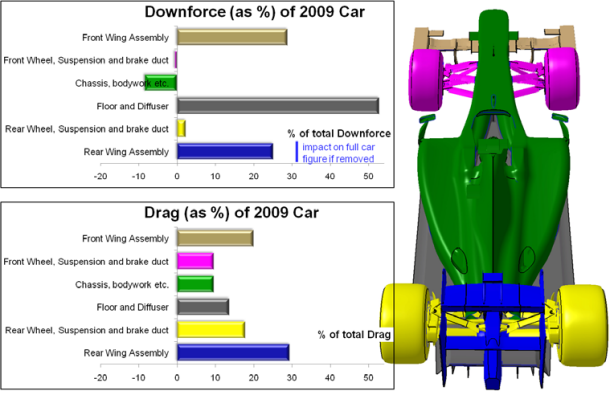bhall II wrote:Just_a_fan wrote:The document has a lot of ideas in it that appear to have disappeared in to the fog surrounding F1.
It reads like a dystopian sci-fi nightmare...
The chassis, including all bodywork, cooling ducts, radiators and major suspension parts will be subject to an annual homologation process. The list of parts and details of homologation will be decided in association with the Cost Reduction Working Group.
[...]
The under-tray will be specified by the Overtaking Working Group and designed (a) to produce the aerodynamic characteristics required and (b) to be mechanically stiff so that aero-elasticity issues are avoided. The part is not only to be prescribed, but also supplied by a third party.
[...]
The desire to bring to a halt the pursuit of downforce extends to the whole vehicle. Thus the chassis itself must also comply with the no overlapping surface rule. This effectively bans barge-boards, [?]-wings, chimneys, flip-ups, and the like.
[...]
There are a number of items on the cars which offer little advantage in terms of anything that race fans would appreciate, but are very costly as they are unique to each team and freedom is allowed in development. Some of these have a marked affect on downforce generation. In particular the whole wheel-upright-brake-and brake-duct assembly is a sensitive aerodynamic part. Clearly the prescription of these parts offers a double benefit, firstly as it draws a halt to their non-road-relevant development and secondly because prescription should lower the reproduction costs considerably. Thus the FIA will put to tender the following:
- Wheels, uprights, brakes (and associated system), brake ducts i.e. the complete "corners" of the car
[...]
The introduction of prescribed uprights has the consequence that the outboard suspension pick up points are fixed, constraining the suspension design. It is suggested that the "corner" design is based on the design that wins the 2007 constructors championship.
[...]
A turbulence sensor complete with an aircraft type back up system (for robustness) will be supplied by the FIA. When travelling in high turbulence levels such as those generated by the close presence of a leading car, the ride height of the car, both front and rear, must be altered in response to the output of this sensor (within a set range, at a set rate, and with appropriate hysteresis, determined from time to time by the FIA) to compensate for the degradation in performance. In free stream the car is to return to a baseline ride height. The purpose is to allow for full compensation for downforce losses due to being in the wake of another car.
That last bit ought to tickle Andres to pieces. Can't say I ever thought I'd see legitimate proposals for wholesale standardization in Formula One, though. Despite being conjured up ten years ago, when F1 was a very different animal, I'm still surprised by that.
I´m not a fan of standarization either, but when you think about it, F1 actually is standarized in so many aspects (engine size, type, dimensions, CoG, wings sizes, materials, flexibility, tires, suspensions, cockpit, gearbox, ERS....) I can´t see how standarizing some more will make any difference

The difference would be they could provide close battles. I very much would prefer a 30% standarized F1 wich provides close battles, than current situation with 25% standarized cars wich cannot provide close battles. Percentages are invented obviously, just trying to explain it better
PS: so the OWG did a similar proposal but you keep repeating that´s absurd, I don´t understand aero, etc.????


